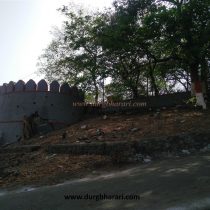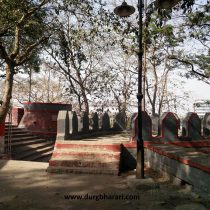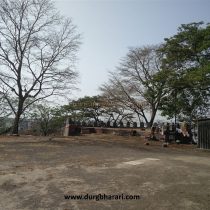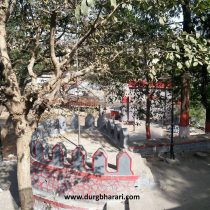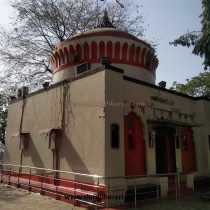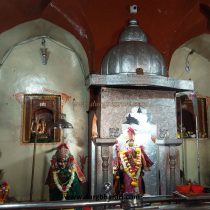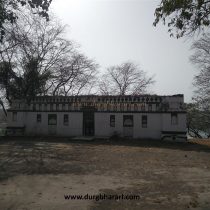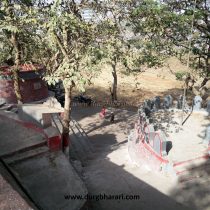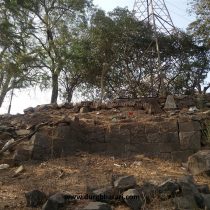DURGADI
TYPE : COASTAL FORT
DISTRICT : THANE
HEIGHT : 0
GRADE : EASY
The city of Kalyan in Thane district has a rich historical heritage. Shivaji Maharaj had established the first naval fleet of the Maratha Empire on the Durgadi fort in this city. The river Ulhas, which originates in Borghat, meets the sea near Vasai. The Ulhas River is a tributary of the Bhatsai River which originates near Kasara Ghat and the Kaal River which flows through Malshej Ghat. Due to the abundance of water in this creek, huge ships used to often visit this creek in the past. Kalyan port and city are located on the banks of Ulhas Bay. You can get off at Kalyan station and reach Durgadi fort in 15 minutes by bus or private vehicle. The Durgadi fort, which bears witness to the history of the Shivaji Maharaj’s period, stands on a small hill on the bank of the creek at the entrance of the city of Kalyan.
...
On the way to the fort, the equestrian statue of Chhatrapati Shivaji Maharaj in the fork near the fort attracts our attention. An arch is currently erected at the entrance of the fort. The entrance of the fort has been destroyed but the bastions adjacent to it remain. The bastion has a newly installed small marble idol of Ganesha and this door is known as Ganesha Darwaza. The path on the left side of Ganesh Darwaza leads to the watchtower, while the path on the right side leads to the Durga Devi temple. It is possible to reach the back of the fort from the watchtower but it is forbidden to go there. The temple of Goddess Durga is small and was renovated by Ramji Mahadev Biwalkar, Subhedar of Kalyan during the Peshwa period. There is a new idol of Goddess 3 feet high in the temple. The base of the temple is small and the apex is round. Dargah is at the back of the temple and there are steps at the back to go there but at present, it is forbidden to go here. In addition to this, there are two large broken bastions and the remains of a small rampart on the side of the creek. Other remnants of the fort have disappeared in the course of time and the pathetic efforts made for the conservation of the fort can be seen. As you walk along the roadside of the fort, you can see the old fortified stones and new constructions. Half an hour is enough to see the fort and its surroundings. During the Satvahana period, Kalyan was known as a port. In the Middle East, Rome was the center of trade and commerce. Goods arriving at Kalyan port were sent from Rome to Junnar and Paithan via Naneghat. After the Nizamshahi rule of Ahmednagar, this part came under the control of Adilshah of Bijapur. Chhatrapati Shivaji Maharaj took possession of this region which was under the control of Adilshahi on 24th October 1657. At this time, Kalyan city had strong fortifications, 11 bastions, and many gates for protection. “Who owned forts owns the lands, who owned naval fleet owns the sea” this mantra was known by Shivaji Maharaj. With the capture of important ports like Kalyan, Shivaji Maharaj realized that the enemy could attack him by land as well as by sea, therefore, Maharaj ordered Abaji Mahadev to build a fort near the hill fort close to the creek in Kalyan. While digging the foundation for the fort, a huge amount of gold and silver articles were found here. The fort was named Durgadi after realizing that it was by the grace of Goddess Durga that these articles were found while the fort was being built. This fort marked the beginning of the Maratha fleet. Along with the fort, Shivaji Maharaj built an armored dock and started building warships. The Portuguese were paid twice as much for this work. 340 Portuguese craftsmen were working here to build the ships. The Portuguese called Durgadi as Godrelas. The Maharaja's fleet was noticed by the French fleet as Shivaji Maharaj, the king of the mountains was now descending into the sea. Realizing this, the French wrote a letter to the Portuguese of Vasai convincing them not to let their artisans work for Shivaji Maharaj. So the artisans here left the work halfway through one night and fled and the rest of the work was completed by the local artisans. Britisher’s of Mumbai, Portuguese of Vasai, and Siddi of Janjira continued to terrorize this fort. In 1682, Mughal chief Hasan Ali Khan conquered Kalyan but Sambhaji Raje attacked and recaptured Kalyan. Later in 1689, the Mughals regained Kalyan. In 1728, the Portuguese attacked Durgadi fort but the chief Shankarji Keshav, Gangaji Naik, and his companions successfully repulsed the attack. This fort, which witnessed many battles and thrilling events, must be visited at least once.
© Suresh Nimbalkar

